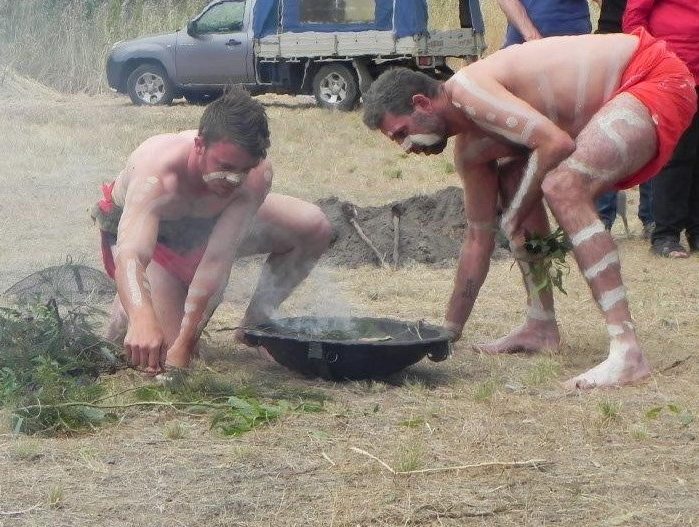| |||||
Catchment health is underpinned by the community’s capacity and interest in caring for land, water and biodiversity. The Wimmera’s large geographical area and small population means active stewardship, sharing of knowledge and resources and collaborations between organisations, community groups and individuals is vital to support continued action over time.

Planting at the Wimmera River near Horsham
Every person and business that lives, works, recreates or has a special interest in the Wimmera uses and influences the natural environment. Human activity has the biggest influence on catchment condition. It is important that the region’s community is knowledgeable, skilled, motivated and informed.
This section focuses on supporting individuals and groups to connect to nature and care for the Wimmera’s land, water and biodiversity. Everyone has a role to play in effective environmental stewardship.
Organisations, groups and individuals in the Wimmera community have expressed the following as important:
- Maintaining and improving the region’s liveability and wellbeing, including economic wellbeing.
- Improving the region’s natural assets and leaving them in better condition for the next generation.
- Providing opportunities for all the community to connect to nature.
- Supporting a strong volunteering culture that improves outcomes for people, communities, and the natural environment they live, work or recreate in.
- Ensuring communities are better prepared to mitigate the adverse impacts of climate change, drought, flood and other natural hazards.
From time to time there will be polarising views and vigorous debate on certain topics. Respectful and considered communications will ensure that the Wimmera’s strong foundations of cooperation and collaboration continue.
Groups and individuals with particularly strong interests and influence in caring for the Wimmera’s natural environment include:
- First Nations people
- Landcare, “Friends of” and other groups involved in environmental volunteering
- Primary producers
- Non-commercial farmers and rural landholders
- Corporate farming businesses
- Mining and resource industry businesses
- Schools and young people
- Residents
- Nature based user groups like anglers, birdwatchers, field naturalist, hunters and camera clubs
- Wimmera-based businesses linked to the agricultural and eco-tourism sectors
These groupings are themselves diverse, constantly changing and often have shared or complementary values.
First Nations

Smoking ceremony by Barengi Gadjin Land Council
The Wimmera is a living cultural landscape rich in values, heritage and kinship. Since creation, the custodial responsibilities to care for Country sat with First Nations people who lived in harmony with the environment and each other. Land management practices and the knowledge of plants, animals and the seasons were passed down from generation to generation through dance, songs, art, action and language.
Country, and caring for Country goes beyond the physical elements of the natural environment and is fundamental to First Nations identities. Aboriginal Places (including known archaeological sites) such as oven mounds, scarred trees, stone quarries, fish traps and artefact scatters sit alongside stories, places of creation, lore and cultural knowledge. First Nations communities bring diverse life experiences and connections to cultural landscapes and special places. Integrated catchment management can be a platform for activities that contribute to self-determination by First Nations communities. While partnership-based activities have a direct benefit in themselves in terms of rehabilitating particular places, these activities also have broader impact of highlighting the role and responsibilities of First Nations peoples in managing Country and contributing to the health and wellbeing of the environment and the community.
Cultural heritage protection is one very important aspect of integrated catchment management, but it is just one aspect. First Nations communities’ interests in participation and engagement in integrated catchment management and partnerships with Catchment Management Authorities (CMA)s and other organisations across this sector are much broader than just cultural heritage protection.
Two-way learning and ongoing collaboration in planning and management across the Wimmera will strengthen partnerships between First Nations people, landholders, volunteer groups and other organisations and result in better outcomes for the region.
Landcare and volunteer groups
The Wimmera has a positive legacy of stewardship and collective action by many landholders, volunteer groups and other organisations. These efforts have influenced every area of the catchment, and demonstrate how coordinated collective action, and the support of committed partners, can result in productivity, environmental and social benefits.
Landcare networks and groups support a grassroots movement of volunteerism across the region. There are more than 60 community-based groups in the Wimmera engaging with approximately 1,400 members and volunteers. Landcare groups cover about 80% of the region’s privately-owned land.
Groups are supported by overarching Landcare Networks or other partnership arrangements that employ support staff and assist in planning, funding and implementing larger projects. The focus of the networks and individual groups varies according to member’s interests and includes sustainable agriculture, soil health, weeds, pest animals, revegetation, water quality, threatened species and wetland protection. Landcare groups across the catchment actively raise public awareness and promote diverse and inclusive partnerships with many other organisations.
The hard work of Wimmera Landcarers has been recognised and celebrated with multiple state and national Landcare awards since the movement began in 1986.
Primary producers
Many individual landholders choose to champion local Landcare principles and practices on their properties outside of formalised group structures.
Many Wimmera residents volunteer their time and energy to assist others. This means Landcare and environmental volunteering is in competition with many other commitments and important areas of need
Major threats and drivers of change
At a regional scale Landcare, like most other volunteer- driven community organisations in the Wimmera, has seen traditional membership rates decline. Changing demographics in rural communities and the overall shift to larger farm businesses are among trends reducing potential for community involvement in natural resource management. There is considerable variation across the region.
At the same time, with the growth of social media and new communication technologies, the number of online communities across the region is growing. These tools and technological capacity provide new opportunities to connect issues and people, especially young people and the region’s growing culturally and linguistically diverse communities. There is also increased potential to increase community participation and engagement in catchment management, such as through citizen science.
There is anecdotal evidence of an increasing focus in school communities and curriculums on sustainability and land, water and biodiversity management.
The above trends carry risks as well as new possibilities. Strategic outcomes for community participation and engagement in regional integrated catchment management need to be developed with an awareness of both.
Population decline is an ongoing issue. Attracting, retaining and sustaining resident populations is a key concern for most towns and rural communities across the Wimmera. They seek to achieve this by increasing the liveability and appeal of their communities. The places where people live, learn, work and play have an important role in shaping health and wellbeing, including economic wellbeing. Integrated catchment management is one of several policy domains influencing liveability.
In town settings, for example, ‘greenspace’ near workplaces and residences provides opportunities for recreation and active lifestyles. Connecting with nature has been shown to benefit physical and mental health, improve quality of life and generate economic benefits. This access needs to be managed to protect biodiversity values from impacts like trampling, erosion, weed dispersal and littering.
The farming sector on which the region’s communities depend is diversifying as new technologies and practices are being adopted to adapt to global economic and climate changes. There is a need for new technology that accelerates positive change at scale, and there are opportunities to continue to build digital connectivity and embrace innovation that links and contributes to building drought and climate resilience.
Pressures on the region’s natural resources can limit the viability of food and fibre businesses and the prospects of sustainable intensification.
Wimmera farmers and communities have a proven capacity to adapt and have been managing a wide range of risks including climate variability and drought for many years. Drought is an enduring, regular feature of the Wimmera. It is predicted that drought conditions will intensify beyond current lived experience, becoming more frequent and longer, with more pronounced impacts.(27)
Prolonged effects on profit and farm viability have reached well beyond the actual event of drought. The Australian Bureau of Agricultural and Resource Economics (ABARES) estimates that changes in climate since 2000 have reduced average annual profits for the region’s approximate 2,628 farm businesses by 35% or $64,400 (controlling for non- climate factors).(67)
ABARES results suggest that, without farmer innovation and adaptations to continue to reduce the sensitivity of farms to dry conditions over time, hits to profitability would have been approximately 49% for cropping farms (compared to 1990 technology). Increased risk of financial and social distress to the sector was also linked to significant impacts on mental health and well-being.
Other important capacity-building pillars to advance integrated catchment management in the Wimmera include institutional coordination and collaboration, robust volunteering infrastructure, and leadership. Expanding and enduring partnerships can drive progress.
There are many different forms of volunteering and the benefits reported by volunteers varies considerably. The Wimmera’s volunteering sector is being asked to evolve and grow by the community. This is coupled with an increase in the demand for the services that volunteers provide. Place-based services, such as Landcare group and network support services and larger volunteer support organisations provide the critical infrastructure required for safe, effective and sustainable volunteering. They are responsible for the promotion, resourcing and support of volunteers in local communities, and assist groups across the region to recruit, retain and manage their volunteers.
Participation and leadership are closely connected. Leadership requires a strong and enthusiastic participant base just as participation requires the direction and structure of strong leadership. Both play an important role in the development of community capacity.
The net loss of young people from the region threatens the Wimmera’s community leadership base. Gaining the interest of the next generation of young leaders in natural resource and catchment management is crucial for maintaining the ranks of volunteer networks and professionals. Young people who are successfully engaged need mentorship and guidance.
Natural resource and catchment management presents a potential growth area for employment for regional Victorians to continue to plan for a future of prosperity.
COVID-19 has the potential to influence volunteerism via health restrictions and concerns. There is also potential for the population and volunteer base to increase as people look to live in regional Victoria.
Desired outcomes for the future
Outcomes to be achieved in 20+ years
- Integrated catchment management provides a platform for activities that contribute to self-determination by First Nations communities.
- All Wimmera residents and visitors have access to nature experiences that enhance health and wellbeing.
- Wimmera people are active stewards taking action to care for land, water and biodiversity
Outcomes to be achieved in 6 years
- First Nations communities are able to develop stronger connections between the Regional Catchment Strategy (RCS) and their own strategies and plans where appropriate and to implement relevant actions.
- More members of the Wimmera community value and experience the region’s natural assets.
- Stewardship increases, with more people taking action to care for land, water and biodiversity.
- New and emerging leaders in integrated catchment management are supported.
- Cultural landscapes are better understood.
- Integrated catchment management contributes to health, wellbeing and economic development (liveability).
Complementary Plans
Landcare Network and Group Plans
A range of local Landcare networks and groups have strategic plans or group action plans. These plans articulate a shared vision about the future of a local group area, highlight tasks that need to be completed to realise the group’s shared vision, and identify who will carry these out. The Project Platypus Strategic Plan, for example, outlines the history and vision of the network of eleven Landcare groups.
- Landcare Australia Strategic Plan 2020-2023
- Victorian Landcare Program Strategic Plan
- Victorian Landcare Network Strategic and Operational Planning
Landcare and Community Participation Plan
Wimmera CMA’s Landcare and Community Participation Plan is an operational plan for engaging Landcare and the community in regional scale natural resource management and the design and delivery of projects that acknowledge local conditions and align regional community priorities with Australian and Victorian Government priorities. The plan aligns with the strategic directions of the Victorian Government’s Landcare Program and Environmental Volunteering Plan, which outlines four focus areas to address the challenges and issues currently experienced by the sector and offers ways to overcome barriers to attracting new volunteers.
Aboriginal Participation Guideline
The Aboriginal Participation Guideline for Victorian Catchment Management Authorities establishes a statewide approach for use by CMAs to respond to regional variations in cultural diversity, experience in working with Traditional Owners and Aboriginal communities, and natural resource management priorities. The guideline provides a framework for how CMAs can strengthen the effectiveness of their engagement and partnerships with Traditional Owners and Aboriginal communities. It recognises that each CMA region is different and that each will take its own approach in engaging with the diversity of Traditional Owners and Aboriginal communities within its region and provides Traditional Owners and Aboriginal communities with an entry point for engaging with CMAs.
Supporting local volunteers
Partner organisations such as the Centre for Participation operate strategic plans focused on supporting local volunteerism across sectors including the natural resource management sector. These plans establish the value of regional collaborations and partnerships to ensure we focus our resources for maximum impact and effectively empower smaller community organisations and volunteer-involving organisations to do their work.




